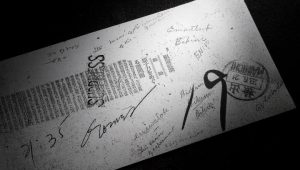Striving to fill voids in Hiroshima, Chugoku Shinbun and the press code — Articles about A-bombing in other newspapers, Part 3: National papers, news agencies
Sep. 7, 2024
Reflection of deepening conflict between U.S. and Soviet Union
by Kazuo Yabui, Visiting Senior Staff Writer
A huge amount of materials regarding censorship by the General Headquarters of the Allied Powers (GHQ) is archived in the Prange Collection. Of those, the Chugoku Shimbun has focused on more than 15,000 “unsorted” materials to investigate the censorship status of articles involving the atomic bombings in regional and local newspapers published in Nagasaki. But what was the situation with respect to national newspapers and news agencies?
We were able to confirm that, because they were deemed to be in violation of the press code (reporting guidelines), 10 articles by five media companies had been prohibited from publication, and certain parts of 11 articles by eight media outlets had been deleted.
The majority of the articles in question were written between around 1947 and 1948, a time of intensified confrontation between the United States and the Soviet Union. As a reflection of the international situation, many such articles reporting on issues like the nuclear testing by the United States, the deployment of atomic bombs, the Soviet Union’s progress in the development of such weapons, and the international controls placed on nuclear power were found to be “in violation” of the press code.
For the Mainichi Shimbun, an editorial titled “The many issues surrounding nuclear power” was prohibited from publication after the article was submitted for the censorship review process on May 21, 1948, prior to publication.
Focus on “controls”
After the end of World War II, a major focus of the international community was how to “control” atomic bombs, a new kind of weapon developed by the United States. In June 1946, the United States submitted a proposal known as “the Baruch Plan” to the United Nations Atomic Energy Commission (UNAEC). The plan proposed such ideas as establishment of the International Atomic Energy Agency (IAEA) and the elimination of nuclear weapons after peaceful use of nuclear power was guaranteed.
The Soviet Union opposed the plan, however, because it feared the United States’ monopolization of nuclear technology. An editorial carried in the Mainichi Shimbun stated, “Uncontrolled competition in nuclear power is anticipated to begin.” The article foresaw the coming of the nuclear arms race.
Likewise, an article by Jiji Press, submitted on June 7, 1948, prior to publication, which touched on confrontation between the United States and the Soviet Union, was also prohibited from publication.
Albert Einstein, winner of the Nobel Prize in Physics, sent an open letter to the Second General Assembly of the United Nations in 1947 calling for the establishment of a supranational “world government.” However, four Soviet scientists jointly offered a counterargument to Mr. Einstein’s proposal. The Jiji Press article provided commentary about the background to that situation.
For both articles, no documentation remains as to the reasons for prohibition of publication. As the Cold War era began, did the GHQ intend to prevent coverage of the Soviet Union’s side of the story?
Other articles were also prohibited from publication. They included an article by the Associated Press (AP), submitted by the Kyodo News Service and the Yomiuri Shimbun on January 12, 1948, prior to publication, revealing a British newspaper had reported that the U.S. Mediterranean fleet was carrying aircraft equipped with nuclear weapons. Another was a Kyodo News Service article, submitted on March 27, 1948, prior to publication, involving a sixth atomic bomb test planned by the United States on the Eniwetok Atoll in the Marshall Islands, located in the Pacific Ocean.
The GHQ’s intention is also clearly evident in the articles from which certain parts were deleted.
“Several times more powerful”
For example, an article by the Sun Photo News, submitted on December 9, 1947, prior to publication, reported on the U.S. Atomic Energy Commission (AEC)’s warning about a new atomic bomb test on the Eniwetok Atoll. The newspaper was ordered to delete the part of the article indicating, “The new atomic bomb is several times more powerful than the one dropped on Hiroshima.”
In another article by Kyodo News, submitted on February 3, 1948, prior to publication, revealed the outline of the AEC’s plans for its science program. The parts of the article outlining the plan’s scope of budget and the establishment of a biomedical department were subject to deletion.
The censorship was designed to prevent certain information from being conveyed to the Soviet Union, including, naturally, anything related to the atomic bombing as well as a variety of other U.S. actions and insights. The GHQ censorship involved strict monitoring of the media and other coverage in Japan. The intensification of the Cold War is also etched into these “unsorted” materials.
(Originally published on September 7, 2024)








